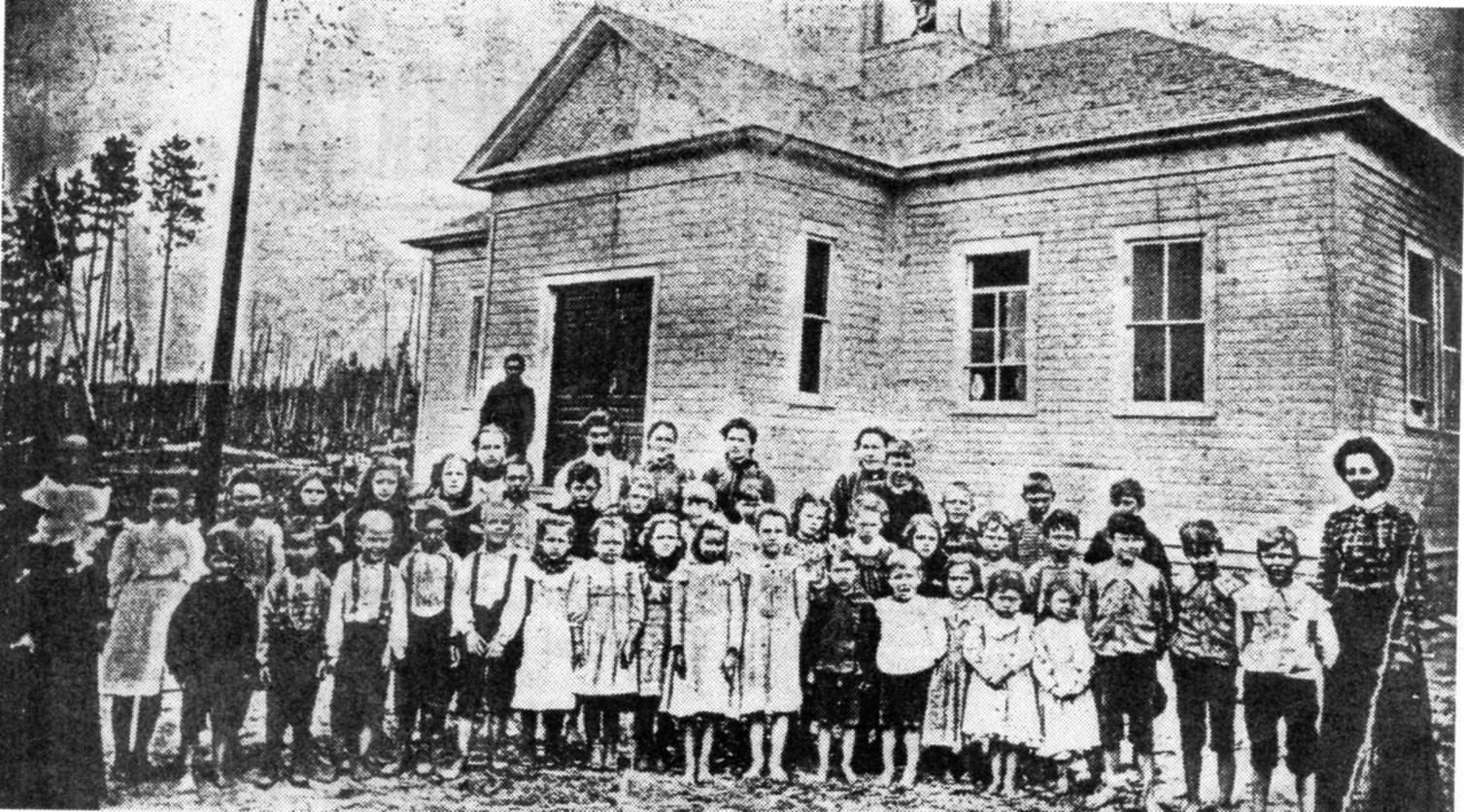
Tower School
Submitted by Nute Chapman
From Onaway Outlook November 1, 2013

 |
Tower School Submitted by Nute Chapman From Onaway Outlook November 1, 2013 |
 |
Forest Township Schools, Tower School
CAPTION: THE NEW SCHOOL in Tower was on the north side of M-68 between Black River Avenue and Barclay Avenue in early 1900.
 There was a log school in the village of Tower before the two-room schoolhouse was built in 1899 at the cost of $700. Ruben
Styes, one of the oldest residents of the area, had a picture of the log building with students standing in the front of it; one
of the students was his brother.
There was a log school in the village of Tower before the two-room schoolhouse was built in 1899 at the cost of $700. Ruben
Styes, one of the oldest residents of the area, had a picture of the log building with students standing in the front of it; one
of the students was his brother.
In 1903 an addition was built on the schoolhouse, more than doubling its size and making it a four-room building with a 10-grade
course of study. John P. Hyde was the president of the board and D.M. Sage was clerk when the frame school was built. The village
of Tower was platted in May 1899. The Tower School was located in Block 5, Lots 1, 2, 3, and 4. Today a home now stands where the
four-room building had been. It is on the north side of the highway between Black River Avenue and Barclay Avenue.
Tower was then a thriving village, which was growing with the building of mills along the Black River and Tower Pond. Many people
were coming to the area, creating the need for the four-room school. Some of the first settlers were Thos. Finan, James Finan,
H.T. Banks, John Barnard and Wm. Gillis. The school employed three teachers during the year 1903-04, W.H. Trafford, Margaret Penoyer
and Maud Clark.
Many of the teachers at that time came from Cheboygan where there was a County Normal School for teacher training. Transportation
was no problem from there with the Detroit & Mackinac Railroad making two daily trips carrying passengers and freight. Usually teachers
boarded at homes in the village or sometimes a group of them would share a house together and then walk to their respective schools each
day. For some, this meant many miles walking to and from school.
During the winter months, some of the teachers would board with a family nearer to the school where they taught. The school in the
village was the center of activities for the area. The teacher of the higher grades acted as principal for all the schools in the
township and received a higher salary.
Some interesting expenditures shown in the records of the 1910 era were for the purchase of 40 yards of toweling and having them
hemmed at the cost of $5.69 from the Meyers store in Tower. A later entry showed $0.48 being paid to Mrs. Kennedy for washing towels.
Thirty-two cords of wood were provided for the Tower school by Gustave Lietaert for $40. A bill of $2 was paid to E.M. Crannel for a
livery rig to the Buzzell School. In 1911 a sanitary drinking fountain was put in the Tower school on a trial basis. The population
reached its peak between the years 1908 and 1914. Later, only two rooms in the school were used as classrooms. Mary Ennes Lyon
recalled going to school there as a child in the 1920s era and remembering the picture of Ellen May Tower hanging on the wall. She
was a Spanish-American war nurse for whom the village of Tower was named. She was the first woman to give her life for the United
States; serving the Spanish American War. She died of typhoid fever in December 1898. Mary often wondered what ever happened to the
picture.
The school had entryways from three sides of the building. There was a large woodshed, which was an excellent building to play
“anti-eye-over” at recess and lunchtime. There was room on one side of the schoolyard for playing ball for the older children and
on the opposite side, plenty of room for the smaller children’s games of London Bridges, Drop the Handkerchief and Pump-Pump-Pull Away.
In the winter one of the unused schoolrooms made a good place to play marbles.
The other unused schoolroom was kept locked and still remained with things in it as it had been used as a schoolroom years before.
To have a peek into that room was like stepping into an attic full of memories of the past. Just seeing the perfect handwriting still
on the blackboards whetted our curiosity and made us wish we could have been part of the school in earlier years.
Patriotism was a very important part of school life. The songs in the old School Song Knapsack included many that stirred our
hearts with love of our country.
In 1918, when Miss Marie LeGault was a teacher in the higher grades, a local soldier from Tower in World I, Jerry LeFleur, was the
first to die and be brought home from Fort Custer. He had died from the influenza epidemic. Miss LeGault had the children from the
school march to the cemetery and sing at the graveside service, an act of respect they never forgot.
To be continued next week.
--From the Onaway Outlook, November 1, 2013, p. 3
Retyped by J. Anderson